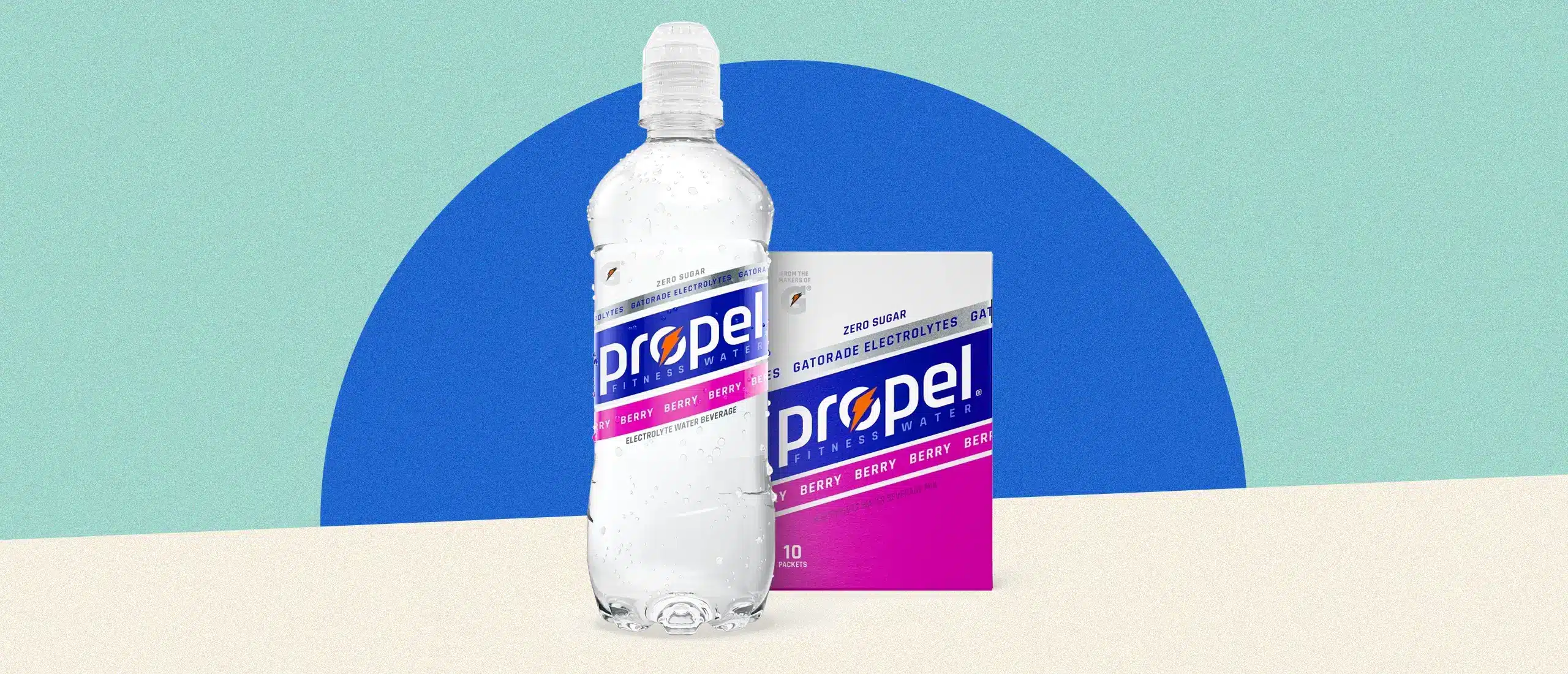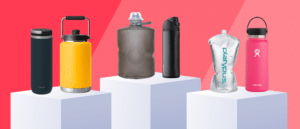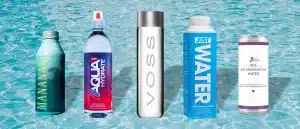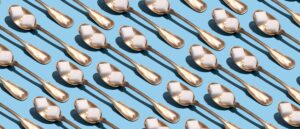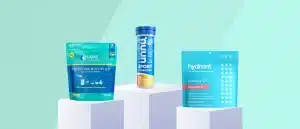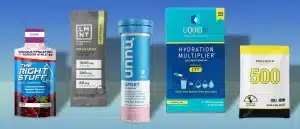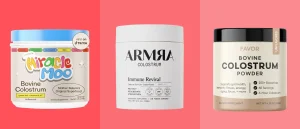Is Propel Water Actually Healthy?
I used to be a Gatorade addict. That is until Propel rolled along. I mean, tell me something that tastes better than a Kiwi Strawberry Propel after a youth soccer game. I’ll wait. But Propel isn’t just for kids. Whether it’s a hot summer day, I’m on a hike, or just want a solid afternoon pick-me-up—the stuff is downright addicting.
I also have an obscene number of core memories that involve my mom nattering on about Propel being a healthy choice. Which, I honestly never stopped to question. Until now. Is Propel actually healthy? Is it healthier than Gatorade? And, more importantly, will it break a fast or pull you out of ketosis? Here’s the down low.
What is Propel Water?
If you didn’t have the pleasure of growing up with a bottle of Propel plastered to one hand, let me introduce you. Propel Water is a brand of flavored water that contains no calories and no added sugar. The formula hasn’t seen many changes since it was originally launched by Gatorade in 2002. It contains a few essential vitamins (vitamins C, B3, B5, B6, and E) and electrolytes to keep you hydrated.
Is Propel Good For You?
Mostly, yes. But it’s not all great. Here’s the scoop.
It has no calories or sugar
Since Propel has zero calories and no added sugar, it’s undoubtedly a better option than sugar-laden sports drinks, like Gatorade—which packs 36 grams of sugar per 20-ounce bottle. That’s the American Heart Association’s recommended max intake of 36 grams of added sugar per day for men (1).
The extra sugar might be good if you’re an athlete seeking rapid recovery from a particularly intense workout; but most of us need less sugar in our diets, not more. Excessive sugar intake is a known driver of inflammation. Left unresolved, chronic inflammation can contribute to everything from heart disease and type 2 diabetes, to erectile dysfunction and a shorter healthspan and lifespan (2). Exactly why Propel is superior for the average gym goer or someone just looking for a tasty way to stay hydrated.
Formulated with essential vitamins
The vitamins in Propel are synthetic: ascorbic acid (vitamin C), niacinamide (vitamin B3), calcium pantothenate (vitamin B5), pyridoxine hydrochloride (vitamin B6), and vitamin E acetate (vitamin E). Synthetic vitamins aren’t uncommon in foods and supplements. However, they’re not always as bioavailable (3)—or as easy for your body to absorb—in an isolated micronutrient profile such as Propel.
For example, vitamin E is a fat-soluble vitamin, meaning it needs to be paired with fat for optimal absorption. The tl;dr: you’ll absorb the vitamin E in Propel better if you pair it with a healthy, fatty snack like a handful of almonds.
Contains electrolytes
Propel is formulated with a blend of two essential electrolytes: potassium and sodium. Electrolytes are electrically charged minerals that help with everything from regulating muscle and nerve function to maintaining pH levels and balancing fluids.
To feel your best, you want to get the amount of sodium just right. High sodium electrolyte supplements (500mg per serving and up) are ideal if you’re running a marathon or doing hours of physical labor on a hot day, while lower sodium levels (less than 500mg per day) are better for low-intensity workouts, Valerie Gately, MS, RDN, LD, previously told The Edge. For day-to-day electrolyte supplementation, she recommends looking for 250mg of sodium and down. Propel hits in the sweet spot with 270 mg of sodium per 20-ounce bottle.
Contains preservatives
Propel contains a few common preservatives: Potassium sorbate and sodium hexametaphosphate.
Potassium sorbate is a man-made chemical preservative that has been used for almost 200 years to protect food, drinks, and personal care products from spoiling, according to the USDA. It’s been cleared by the Food and Drug Administration (FDA) as “GRAS”—Generally Regarded as Safe—and the Center for Science in the Public Interest as safe. The Environmental Working Group (EWG) gives it a low-risk score regarding the potential to cause cancer as well as concerns for developmental and reproductive toxicity.
The FDA also recognizes sodium hexametaphosphate as GRAS. However, you’ll want to avoid going overboard on the stuff, as the research on sodium hexametaphosphate is severely lacking. One report cautions the potential side effects could include nausea, vomiting, diarrhea, and heart and nervous system effects (4).
Sweetened with artificial sweeteners
Just because Propel doesn’t have sugar, doesn’t mean it’s free of all evils. It gets its hyper-sweet taste from no-calorie controversial sweeteners acesulfame potassium (acesulfame K) and sucralose. Artificial sweeteners are FDA-approved and considered safe for human consumption in small amounts (5).
However, non-nutritive sweeteners—including acesulfame K and sucralose—have been linked to changes in the gut microbiome and glucose homeostasis, decreased satiety, and increased caloric consumption and weight gain (6). One study found Acesulfame K is associated with an increased risk of cancer (7). Experts caution more research is needed to confirm the effects of artificial sweeteners (8).
Is It Okay to Drink Propel Instead of Water?
Sometimes. Replacing a few cups of water with Propel is fine. And if you’re wondering if Propel counts towards your eight cups a day, the answer is yes. During intense exercise, you may benefit from drinking more than one Propel.
However, Propel contains the artificial sweeteners sucralose and acesulfame K—which could have health risks if consumed in excess amounts (8). For this reason, water is a definitively healthier choice.
If you do need to boost electrolytes but want to avoid the artificial sweeteners in Propel, try an electrolyte powder or Gatorade Fit (which has a similar electrolyte profile to Propel but is sweetened with purified stevia leaf extract).
Is Propel Healthier than Gatorade?
Yes. A 20-ounce bottle of Propel contains 0 calories and 0 added sugars; while a 20-ounce bottle of Gatorade contains 140 calories and 36 grams of sugar—that’s a lot of sugar.
In the rare case that you’re an athlete in need of rapid carb supplementation post-workout, Gatorade might be your best option if refueling with Propel (or better an electrolyte beverage without artificial sweeteners and low to no sugar) and a snack—like a protein bar or an apple and peanut butter—isn’t an option.
Gatorade also contains red dye 40. Although the World Health Organization claims red 40 does not present a health concern (9), it contains benzidine—a known human carcinogen permitted in food products in low amounts (10). Propel, on the other hand, has no artificial colors.
Propel FAQs
You have questions about Propel Water, we have answers.
Can I drink too much Propel?
Yes. Drinking too much Propel can send you overboard on electrolytes, specifically sodium. When combined with sodium in salty snacks or other food you eat throughout the day, the sodium in Propel starts adding up quick. Too much sodium can raise your blood pressure (11), has been linked to premature death (12), and might reduce immune cell function (13).
Even though sodium is an essential mineral, the Chronic Disease Risk Reduction (CDRR) intake is set at 2,300 milligrams per day (14). That means to lower your risk of chronic disease, you should aim to stay under that number.
Plus, it’s safest to take in only small amounts of the artificial sweeteners found in Propel every once in a while, according to Mayo Clinic. So if you’re drinking a case a day, consider this your cue to cut back.
Can Propel help with weight loss?
It depends. Since Propel doesn’t have any calories or added sugar, it’s a great replacement for drinks you’re trying to shake that do (like soda, juice, or sweet coffee drinks). However, Propel isn’t a magic potion for weight loss. But it might help you cut back: Switching from sugar to zero-calorie sweeteners—at least, when their use leads to a reduction in total calorie intake—has been linked to short-term weight loss (8).
That said, the long-term use of artificial sweeteners is linked to an increased risk of obesity, type 2 diabetes, cardiovascular disease, and mortality (8). So, Propel might not be your best bet for weight loss or health in the long run.
Does Propel break a fast?
Technically, no. Low and zero-calorie drinks like water, sparkling water (look for a PFA-free option), flavored waters, coffee, or tea are unlikely to significantly compromise your fast in any way, Registered Dietitian, Imashi Fernando, M.S., R.D., previously told The Edge.
Whether you’re intermittent fasting or braving a 48-hour fast, it’s important to avoid foods or drinks that spike your glucose to get the major benefits of fasting, like autophagy. Since Propel has no calories and no sugar, it won’t spike your blood glucose.
Want to know for sure? Wear a continuous glucose monitor, which measures your glucose levels every few minutes.
Is Propel keto-friendly?
Yep. Go ahead and drink Propel if you’re following a keto diet. Since Propel doesn’t have any calories, sugar, or carbs it won’t add to your daily net carbs or take you out of ketosis. Plus, it’s an easy way to get your sweet fix if you’re missing other sweet drinks or treats that typically don’t squeeze into the low allotment of carbs allowed in a keto diet.
Is propel water packaged in plastic?
Yes, Propel is available in plastic bottles or plastic packets. Both are recyclable. In the interest of saving plastic, the packets are the obvious choice. But staying away from plastic in general might be wise.
Microplastics, which are found in everything from water bottles to plastic bags may impact male fertility and sperm quality (15). A 2024 study published in the Proceedings of the National Academy of Sciences found that each liter of brand-name water contained between 110,000 to 370,000 nanoparticles (Although, researchers did not disclose which brands) (16).
Does propel water have caffeine in it?
No. Propel does not contain caffeine.


